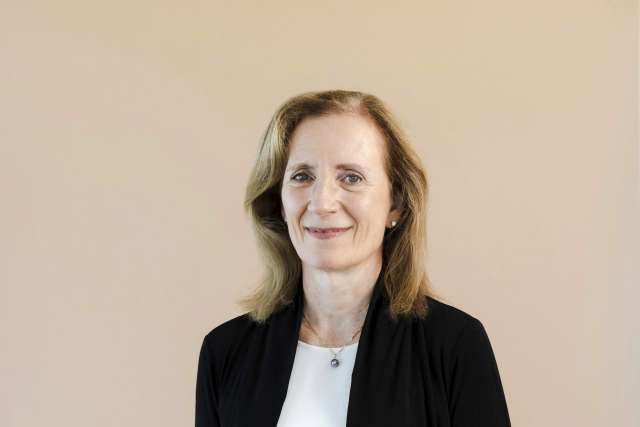Carol Mangione, MD, has a new title to add to her already crowded business card: chair of the U.S. Preventive Services Task Force (USPSTF). Created in 1984, the USPSTF is an independent, volunteer panel of national experts in prevention and evidencebased medicine that makes evidence-based recommendations on clinical services such as preventive screenings, counseling and use of medications aimed at preventing illness. Dr. Mangione, whose other titles include Distinguished Professor of Medicne in the David Geffen School of Medicine and Distinguished Professor of Public Health in the UCLA Fielding School of Public Health, as well as director of the UCLA Resource Center for Minority Aging Research, has been a member of the preventive services panel since 2016 and was vice chair from 2020 to 2022. She spoke with Enrique Rivero, senior media relations officer for UCLA Health, about her new role, lessons learned from the COVID-19 pandemic and dealing with the glut of misinformation that is choking the national dialogue about scientific and medical issues.
Let’s jump right in with the hard stuff. How do we break through the noise of disinformation to disseminate and create acceptance for accurate, evidence-based scientific and health-related information?
Dr. Carol Mangione: This is a huge problem right now. With the proliferation of social media and the internet, it’s very hard for the public to sort through all the uncurated information that is out there. Transparency is essential, and the task force has a long history of publishing our methods on our website for anyone to read. If we are addressing a new topic, we post our research plans on the website for public comment, read and give consideration to every comment we receive, and then we post the final research plan and our draft recommendations before we publish them. Part of why the task force is so trusted is because we have always employed rigorous, transparent, evidence-based methods to develop our recommendations. To grade a recommendation, the key metric we use is net benefit for the patient. We always are balancing benefit against harm. No service comes without both sides, so we have to have moderate-to-high net benefit to be able to give an A-grade or B-grade recommendation. When we find that there is no net benefit or there is potential harm from a given service, we will give that recommendation a D-grade, and we use an I-grade when there is insufficient evidence for or against the use of a preventive service.

What lessons have we learned over the course of the pandemic?
Dr. Mangione: I think what we really have learned is that access to care and services is fragile. When the pandemic happened and all of a sudden there were a lot of new rules and policies to try to reduce transmission of COVID-19, combined with people’s fears about coming to health care facilities, we saw a dramatic decrease in access to care. People were making a judgment call about whether or not it was safe to come in for a service, such as colonoscopy to screen for colorectal cancer, or if it was best to postpone the screening. It is well-documented that many people in the U.S. missed out on a lot of services, and now we’re really playing catch-up. There is a little bit of a silver lining in how health care systems across the country addressed the access problem, UCLA included, by pivoting quickly to virtual visits. Not every patient service requires an in-person visit, so a lot of preventive services, like counseling for smoking cessation, can be done just as well with a virtual visit. Telemedicine has opened up another way to deliver services. Patients often times prefer it, and I don’t think there’s any going back.
In your role as chair of the task force, what do you see as the most significant challenges facing us on the national level?
Dr. Mangione: Access to care continues to be the biggest challenge for use of preventive services. For example, when we look at national population-based data such as the cancer-registry data, who gets cervical cancer? For the most part, patients who have never been screened. Who are these patients who have never been screened? They tend to be among the low-income population and from rural communities. They also are more likely to be Native Americans or Black persons. All of these social, ethnic and racial factors affect access to potentially life-saving screening. So, here we are with a test that can detect cervical cancer early and prevent deaths from cervical cancer, and yet, during the last four decades we can’t seem to get it into the hands of all those who are eligible for screening in our country. To me, that’s the biggest problem we face.
What can the task force do?
Dr. Mangione: Every year we report to Congress about critical evidence gaps that are driving disparities in health care and worsening the health of people in the U.S. Continuing to raise these issues for the people who fund medical research in this country is very important. Partnering with organizations that advocate for some of the highest-risk groups in the country is also very important. Representatives from these groups come to our meetings and observe our processes, and when our recommendations go out for public comment, they will make comments and pick up on things that we might have missed or need to emphasize. And we’ve been very focused on making sure there is broad racial, ethnic, gender and geographic representation on the task force. Having broad representation that includes racially and ethnically diverse clinicians and clinicians from all regions of the United States means that we have people at the table who are thinking about populations that have the most adverse health outcomes from conditions that we screen for. We need more of a national approach that recognizes this problem and puts the resources in the right place to really begin to address universal access to preventative services.
What about mitigation of systemic racism in the development and implementation of preventive services?
Dr. Mangione: The task force has published proposed actions to address these issues. Among them are careful consideration of opportunities to reduce health inequities when selecting new preventive-care topics and prioritizing current topics; purposefully seeking evidence about the effects of systemic racism, health inequities in all research plans and requested public comments and integrating available evidence into evidence reviews; and summarizing the likely effects of systemic racism and health inequities on clinical preventive services in USPSTF recommendations. The USPSTF will pilot test the implementation of these actions on USPSTF topics that hold the most promise for mitigating health disparities.
What is your most urgent concern right now?
Dr. Mangione: The disproportionate underuse of services among people who have the highest prevalence of medical conditions and the worst health outcomes. If we are going to move the needle for health in this country, we’re going to have to address this. COVID-19 was a terrible thing, and it has killed more than a million Americans. But if we look at the actual numbers, what we see is that the loss of life was the highest among Latino people. It was also very high among Black people. This is unacceptable. The virus isn’t selective. It is not choosing which populations to strike hardest. Something else in our society is driving this. If we had fair and equal access to resources, I don’t think we would see a differential in who dies from breast cancer or who dies from cervical cancer or who dies from prostate cancer, so, it isn’t all just about screening. Even if we fix the prevention problem completely, we still have to have the systems in place to deliver evidence-based treatments to the people who are diagnosed with serious conditions.
What is your greatest hope?
Dr. Mangione: My greatest hope is that we get the right services to the right people at the right time. But it is important to understand that the task force never considers coverage decisions. For us, it’s all about health benefit balanced against harms and coming up with evidence-based recommendations that, I would say, are completely insurance-coverage and cost agnostic. When the Affordable Care Act passed, the legislation said that for people with private or commercial insurance, all Grade A and Grade B recommendations have to be covered with no patient cost sharing; that’s a huge step in the right direction. But the task force has no regulatory or decision-making power that influences who ends up insured in this country and who has access to services.
The task force’s recommendations have not been without controversy.
Dr. Mangione: That is true. Since our last breast-cancer screening recommendation came out in 2016, there’s been a long-running controversy about the value of screening annually versus every two years. There has also been controversy about whether to start screening at age 40, at age 45 or at age 50. Some professional organizations have recommendations with earlier starting ages and greater frequency of screening. In 2016, the task force looked very carefully at the evidence and the marginal benefit of screening every two years versus every year in average-risk women and concluded that the benefit of annual versus biennial was so small that we ended up recommending screening every two years. Some groups felt strongly that that was a big problem and push for screening that is more frequent for higher risk groups like Black persons. The task force takes this concern very seriously and will continue to carefully examine the evidence that supports specific screening intervals. If we were to see evidence that shows that the benefit of starting a preventive service at a younger age or using it more frequently outweighs the harms in one group versus another, then these findings would support the development of groups-specific recommendations. But, unfortunately, this evidence from well-designed studies is often times very hard to come by.
What role can the task force play in increasing access to care?
Dr. Mangione: I think the biggest role we can play is to point out the problem to the people who pay for research and pay for health care in our country. Our reports to Congress often focus on disparities in access to care and outcomes. Our recommendations fall into three categories: screening tests, preventive medications for conditions like high cholesterol and short behavioral interventions that can either be delivered in primary care or referred from primary care, such as brief interventions to reduce unhealthy alcohol use. We feel strongly that for the health of the nation, people should have access to these screenings and treatments, and our role can be to communicate this to the public and to make it clear in our recommendations where there are challenges for implementation. We also have a section in our recommendations called “clinical considerations” — often that is where we will talk about access issues — and a section on research gaps, which often focuses on equity issues with health care delivery. With our national platform, the task force is in a position to talk to legislators, to talk to people who fund research, to people who fund clinical care, and to point out to them these big problems that need to be addressed if we are to improve the health of all Americans.

